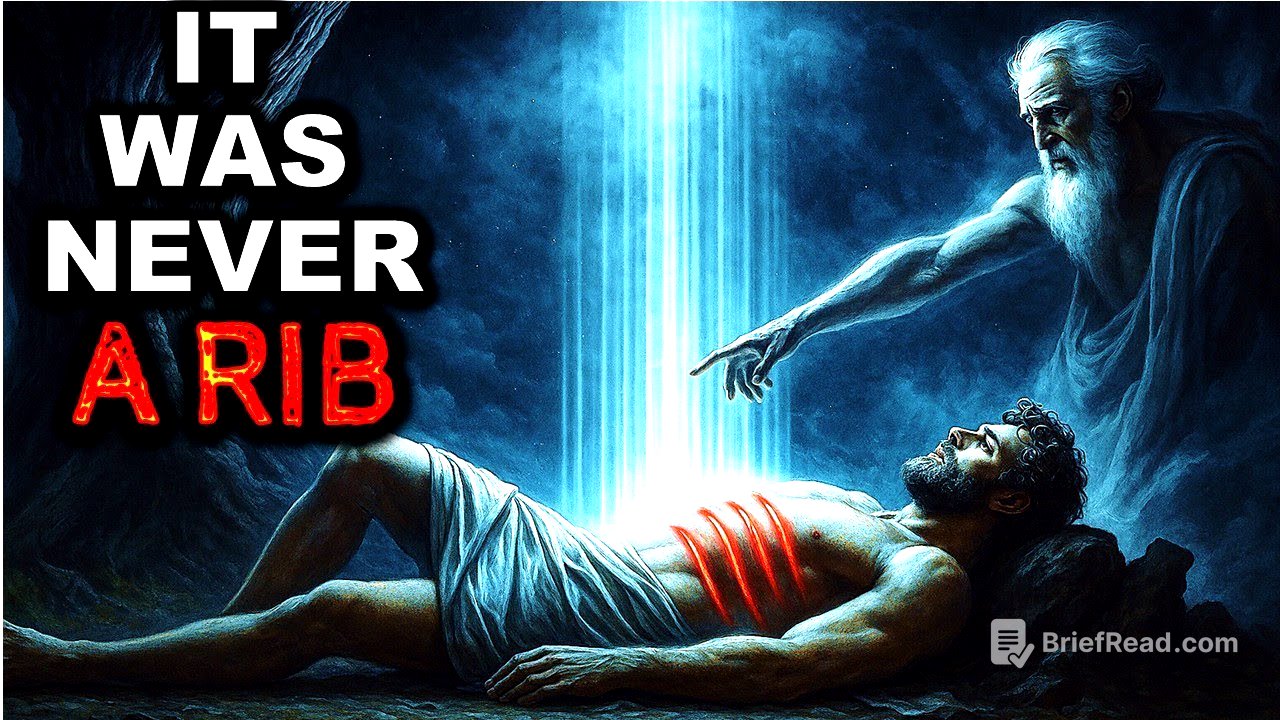TLDR;
This video explores the mistranslation of the Hebrew word "tzela" in Genesis, traditionally interpreted as "rib," and argues it should be understood as "side." This mistranslation has led to centuries of misunderstanding regarding the creation of Eve and the roles of men and women. The video highlights the Ethiopian Bible's preservation of the original meaning and emphasizes the restoration of equality and partnership through Jesus, the second Adam.
- The word "tzela" means "side," not "rib."
- Eve was created from Adam's side, signifying equality and partnership.
- Jesus restores the original design of unity between men and women.
- The Ethiopian Bible preserves the accurate translation of "tzela" as "side."
The Rib That Never Was [1:04]
The traditional story of Eve being formed from Adam's rib is questioned, suggesting the Hebrew word "tzela" has been mistranslated. While commonly translated as "rib," "tzela" typically means "side" in other Old Testament contexts, referring to architectural and structural elements. Examples include the ark of the covenant, Solomon's temple, and the sanctuary in Ezekiel. The translation of "tzela" as "rib" originated from Greek and Latin translations, which influenced Western Christian tradition. Restoring the original meaning of "side" suggests Eve was created from half of Adam's being, not a small, expendable bone. This signifies that woman is not a fragment or afterthought but an equal partner, essential for reflecting the fullness of God.
Adam: The Whole, Male and Female in One [6:35]
Genesis 1:27 states that God created man in his own image, male and female, suggesting that Adam initially contained both masculine and feminine aspects. Ancient Jewish tradition, as seen in the Midrash Rabba and the Talmud, supports this idea, describing the first human as a dual being with both male and female faces. Eve's creation was not an afterthought but the unveiling of what was already within Adam. Genesis 5:2 further emphasizes this unity by stating that God called them "Adam," using a singular name for both. Marriage is viewed as a restoration of this primal unity, with man and woman becoming one flesh as they were in the beginning. This perspective challenges the minimization of women and highlights their essential role in completing humanity and reflecting God's image.
The Divine Architecture of Woman [12:32]
The Hebrew text uses the word "bana," meaning "to build," to describe the creation of Eve, the same word used for constructing altars, houses, and the temple of Solomon. This indicates that Eve was not improvised but intentionally built with divine architecture. Unlike Adam, who was formed from dust, Eve was built from life already alive, from Adam's side, signifying intentionality and purpose. This elevates woman to the level of holy architecture, like a temple where God's presence dwells. The wise woman builds her house (Proverbs 14:1), connecting wisdom and building. Eve's creation carries a message of endurance, design, and purpose, making her structural and essential to humanity's existence.
From Unity to Division: The Fall's Tragedy [17:56]
The initial harmony between Adam and Eve, marked by Adam's joyful recognition of Eve as bone of his bones and flesh of his flesh, is disrupted by the serpent in Genesis 3. The serpent's cunning words lead to the fall, resulting in shame, hiding, and broken intimacy. Adam blames Eve and God, while Eve blames the serpent, shattering the chain of unity. Genesis 3:16, often misread as divine command, describes the consequence of sin: male dominance. This introduces hierarchy where God created equality. The tragedy of the fall is not only humanity's sin against God but also the fracture within humanity itself, leading to patriarchal systems and relational separation. Despite this, the original design of unity, partnership, and equality offers a threat of hope for restoration.
Jesus, the Second Adam, Restores the Side [23:32]
Jesus, referred to as the second Adam, came to restore the unity fractured by the first Adam. He reaffirmed the original design of Genesis 2, bypassing the hierarchy introduced in Genesis 3. Jesus challenged the patriarchal norms of his time by giving women voices and making them visible. He revealed himself as the Messiah to the Samaritan woman at the well (John 4) and entrusted Mary Magdalene with the announcement of his resurrection. These actions overturned cultural assumptions and declared the restoration of equality in his kingdom. Jesus dismantled the walls built by sin, welcoming women as disciples and defending their dignity. Paul's words in Galatians 3:28 capture this truth, proclaiming that in Christ, there is neither Jew nor Greek, neither bond nor free, neither male nor female, but all are one.
The Forgotten Truth and the Ethiopian Witness [29:01]
The Ethiopian Bible preserves a richer, older memory of Eve's creation, aligning with the Hebrew roots of Genesis. It maintains the sense of "side" rather than reducing it to "rib," affirming the woman as a full counterpart. This tradition sings the story of creation with harmony, not hierarchy, emphasizing that Eve was taken from Adam's side, signifying equal dignity and shared purpose. Restoring this true meaning redeems identity and corrects centuries of misinterpretation. The side-by-side design was intentional, woven into the blueprint of creation, making marriage about harmony and community about partnership. The Ethiopian Bible serves as a living testimony to this forgotten truth, reminding us that God's word cannot be silenced forever and that what was hidden will be revealed.









